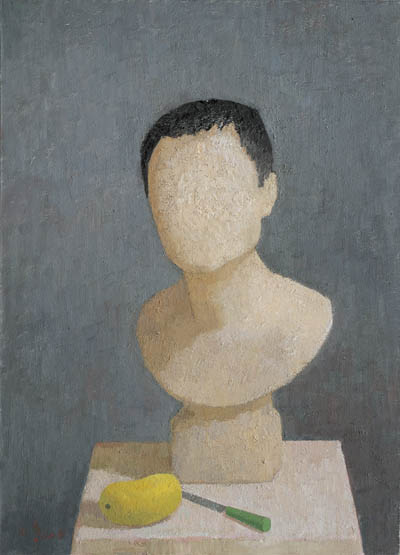WANG YIN: 2009
| February 1, 2010 | Post In LEAP 1

The sparse title of Wang Yin’s solo show at the Iberia Center for Contemporary Art, “Wang Yin 2009,” indicates its simple aim: exhibiting a portion of the artist’s paintings made between 2003 and 2009. Such a limited scope is unfortunate given Wang’s unique position in the contemporary Chinese painting world. The visual territories explored in the exhibition only reinforce the conceptual origins of Wang’s painting practice: specifically, the logical connections between his work, modern Chinese oil painting and the country’s Soviet-influenced art education system.
Although this perspective of Wang’s work is not quite as pervasive as the pop sociological approach, it is a cliché commonly directed at his painting practice. And though it is possible to build a Wang Yin solo show upon this trope, the inadequacy of the curator’s visual and academic vocabulary keeps this idea from being clearly visually conveyed. This results in a flat show with rather weak scholarly presentation. To reference the title of an article Wang Min’an wrote on Wang’s work, “How to “Recapture” the Experience of Painting?,” there is at least one piece of unfinished business in Wang’s show: it fails to construct a set of suitable visual systems to “recapture” Wang Yin’s painting experience for its visitors.
Wang’s show itself exposes the position of painting exhibitions within the contemporary Chinese art world. As a traditional medium holding historical gravity in the contemporary art ecosystem, it is difficult to exhibit painting using conventional means and structures that are then tailored to comment on and present the practices of any one artist, such as Wang Yin. Wang’s importance does not lie in the historical dimensions of visual language, or by extension, in any subjective attitude of consciously rethinking history. Merely using such characteristics to quantify Wang Yin’s practice causes it to be summed up as purely tactical. These historical delusions rid Wang’s work of its usual complexity and trade his study of painting’s internal problems for a mood of superficial nostalgia.
The show’s curator is clearly aware of this problem, and attempts to demarcate these issues in Wang Yin’s paintings by sorting through them. For example, three different self-portraits produced in different years (2005, 2007, 2009) are displayed together, and the visual comparison highlights Wang’s diligent, probing approach to the self-portrait genre. Similarly, his “Spring Grass Grows Beside the Pond” series (2008) mixes expressions of the figurative transformations of the West’s “exoticism” with China’s “romance of the border” within the same visual threshold. But this type of classification is too careless and inflexible for Wang Yin’s work because it is conducted under the easily identified and misleading labels of “history,” “genre,” “image” and “brushwork.” All we are directed to is an outdated mythology generated through semantics. It is hard to say whether this runs opposite to the original intentions of Wang’s painting—if it indeed unearths a set of practical grammatical rules out of a confined linguistic system. Sun Dongdong

